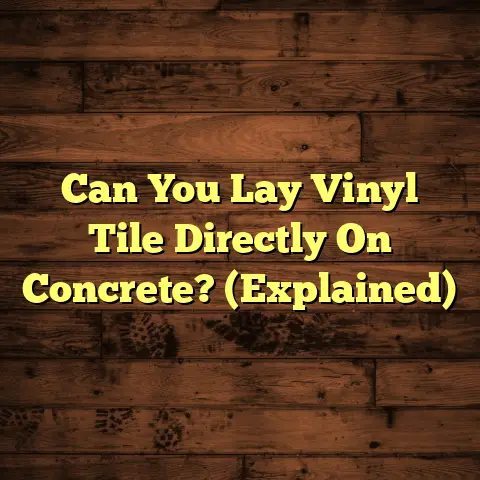Subfloor Over Concrete? (3 Things To Know!)
Ever dream of turning that cold, hard concrete slab in your basement into a cozy living room or a stylish home office?
I get it. It’s a fantastic idea!
But before you start picturing plush carpets and gleaming hardwood, there’s a crucial step you absolutely can’t skip: the subfloor.
Why is the right subfloor crucial for your home’s comfort and longevity?
And what hidden challenges could arise from placing a subfloor over concrete?
Trust me, as a flooring contractor with years of experience, I’ve seen it all – the good, the bad, and the downright ugly when it comes to subfloors over concrete.
Let’s dive into the world of subfloors over concrete!
I’ll share my insider knowledge, the common pitfalls, and the secrets to getting it right the first time.
1. Understanding the Basics of Concrete Subfloors
So, what exactly is a concrete subfloor?
Simply put, it’s the existing concrete slab that forms the foundation of your floor.
It’s the base upon which you’ll build your finished flooring.
Think of it as the unsung hero that provides structural support, thermal mass, and a level surface.
The Good, the Bad, and the Concrete
Concrete is renowned for its durability.
It can withstand immense weight and pressure.
Its thermal mass helps regulate temperature, keeping your home cooler in the summer and warmer in the winter.
However, concrete also presents some unique challenges.
One of the biggest is moisture.
Concrete is porous, meaning it can absorb moisture from the ground below.
This moisture can then wick upwards, potentially damaging your subfloor and finished flooring.
Cracks and imperfections are another common issue.
Over time, concrete can develop cracks due to settling, temperature changes, or even just wear and tear.
These imperfections need to be addressed before you even think about installing a subfloor.
Standard Practices and Materials
When it comes to building a subfloor over concrete, there are a few standard practices I always follow.
First, I make sure the concrete slab is clean and free of debris.
Then, I assess the levelness of the slab.
If there are any significant dips or unevenness, I’ll use a self-leveling compound to create a smooth, even surface.
As for materials, the most common choices are:
- Plywood: A cost-effective option, but susceptible to moisture damage.
- OSB (Oriented Strand Board): Similar to plywood, but generally less expensive and potentially more prone to moisture issues.
- Cement Board: A durable, water-resistant option, ideal for bathrooms and other moisture-prone areas.
Leveling and Preparation: The Foundation of Success
Before laying down any subfloor material, leveling the concrete slab is a MUST.
Even small imperfections can cause problems down the line.
Uneven flooring, squeaks, and premature wear are just a few potential consequences.
I typically use a long level or a laser level to identify any high or low spots.
For minor imperfections, a concrete grinder can be used to smooth out high spots.
For larger dips or uneven areas, a self-leveling compound is the way to go.
This liquid mixture is poured onto the concrete and spreads out to create a perfectly level surface.
Cracks and Imperfections: Don’t Ignore the Warning Signs
Cracks in the concrete are like warning signs.
They indicate potential structural issues or underlying problems.
Before installing a subfloor, it’s crucial to address these cracks.
Small, hairline cracks can often be filled with a concrete crack filler.
Larger cracks may require more extensive repairs, such as patching with a concrete mix or even consulting a structural engineer.
Ignoring cracks can lead to bigger problems later on, including subfloor instability and water damage.
2. The Importance of Moisture Control
Moisture is the enemy of flooring.
It can cause warping, cupping, mold growth, and a whole host of other problems.
When you’re installing a subfloor over concrete, moisture control becomes even more critical.
Why? Because concrete is porous and can wick moisture from the ground below.
The Moisture Menace: How It Happens
Concrete acts like a sponge, drawing moisture from the soil beneath it.
This moisture then travels upwards through the concrete slab.
If you install a subfloor directly on top of the concrete without any moisture protection, that moisture will be absorbed into the subfloor material.
Over time, this can lead to:
- Warping and buckling of the subfloor.
- Mold and mildew growth.
- Rotting of the subfloor material.
- Damage to the finished flooring.
I’ve seen countless flooring failures caused by improper moisture management.
It’s a costly mistake that can easily be avoided with the right precautions.
Moisture Mitigation Techniques: Your Arsenal Against Dampness
Fortunately, there are several effective moisture mitigation techniques you can use to protect your subfloor and flooring.
Here are a few of my go-to methods:
- Vapor Barriers: These are plastic or foil sheets that are installed between the concrete and the subfloor.
They act as a barrier, preventing moisture from wicking upwards. - Concrete Sealants: These are liquid coatings that are applied to the concrete surface to seal it and prevent moisture penetration.
- Dehumidifiers: These devices remove excess moisture from the air, helping to keep the subfloor and surrounding environment dry.
- Proper Ventilation: Ensuring adequate airflow in the space can help to prevent moisture buildup.
Testing for Moisture: Know Your Enemy
Before you even think about installing a subfloor, it’s essential to test the moisture levels in the concrete.
This will give you a clear picture of the moisture situation and help you determine the best course of action.
There are several ways to test for moisture in concrete:
- Calcium Chloride Test (the “Salt Test”): This involves placing a small container of calcium chloride on the concrete surface and measuring the amount of moisture it absorbs over a period of time.
- Relative Humidity (RH) Test: This involves drilling small holes into the concrete and inserting probes that measure the relative humidity inside the concrete slab.
- Electronic Moisture Meters: These devices use electrical resistance to measure the moisture content of the concrete.
I always recommend performing a moisture test before installing a subfloor.
It’s a small investment that can save you a lot of headaches and money in the long run.
Case Studies: Learning from Mistakes
Let me share a quick story about a flooring disaster I encountered a few years ago.
A homeowner decided to install a beautiful hardwood floor in their basement without properly addressing the moisture issue.
They skipped the vapor barrier and didn’t bother to test the concrete for moisture.
Within a few months, the hardwood floor started to warp and buckle.
Mold began to grow underneath the flooring, creating a health hazard.
The homeowner ended up having to rip out the entire floor and start over, this time with proper moisture mitigation in place.
This is just one example of what can happen when you neglect moisture control.
Don’t make the same mistake!
3. Choosing the Right Materials for Your Subfloor
Okay, so you understand the importance of moisture control and you’ve prepped your concrete slab.
Now, it’s time to choose the right materials for your subfloor.
There are several options available, each with its own pros and cons.
Plywood: The Budget-Friendly Option
Plywood is a popular choice for subfloors due to its affordability and availability.
It’s relatively easy to work with and provides a solid surface for installing finished flooring.
However, plywood is also susceptible to moisture damage.
If it gets wet, it can warp, swell, and even rot.
- Pros: Affordable, readily available, easy to work with.
- Cons: Susceptible to moisture damage, can warp and swell.
I generally recommend using plywood only in areas where moisture is not a concern.
OSB (Oriented Strand Board): The Economic Alternative
OSB is similar to plywood, but it’s made from strands of wood that are glued together under pressure.
It’s generally less expensive than plywood, but it’s also more prone to moisture issues.
OSB can absorb moisture more quickly than plywood, and it can also swell and delaminate when exposed to water.
- Pros: Less expensive than plywood.
- Cons: More prone to moisture issues than plywood, can swell and delaminate.
I typically avoid using OSB in areas where moisture is a concern.
Cement Board: The Moisture-Resistant Champion
Cement board is a durable, water-resistant material that’s ideal for bathrooms, kitchens, and other moisture-prone areas.
It’s made from cement and reinforced with fiberglass mesh, making it resistant to water damage, mold growth, and rot.
However, cement board is also more expensive than plywood or OSB, and it can be more difficult to work with.
- Pros: Water-resistant, mold-resistant, durable.
- Cons: More expensive than plywood or OSB, can be more difficult to work with.
I highly recommend using cement board in any area where moisture is a concern.
Climate and Intended Use: Tailoring Your Choice
The best subfloor material for your project will depend on your climate and the intended use of the space.
If you live in a humid climate or you’re installing a subfloor in a basement, moisture resistance is a top priority.
In this case, cement board or a moisture-resistant plywood would be a good choice.
If you’re installing a subfloor in a dry climate and the space is not prone to moisture, plywood or OSB may be sufficient.
Innovations in Subfloor Materials: The Future of Flooring
The flooring industry is constantly evolving, and there are always new and improved subfloor materials being developed.
One recent innovation is moisture-resistant engineered wood.
This material is made from wood fibers that have been treated with a water-resistant coating.
It offers the look and feel of natural wood while providing enhanced protection against moisture damage.
Another innovation is self-leveling underlayment.
This material is designed to create a perfectly level surface for installing finished flooring, even over uneven concrete slabs.
Expert Opinions: Trust the Pros
I always recommend consulting with a flooring professional before making any decisions about your subfloor.
A professional can assess your specific situation and recommend the best materials and installation techniques for your project.
“Choosing the right subfloor material is crucial for the longevity and performance of your finished flooring,” says Mark Johnson, a certified flooring inspector.
“Don’t cut corners on the subfloor. It’s the foundation of your entire flooring system.”
Conclusion
So, there you have it: the three essential things you need to know about installing a subfloor over concrete.
- Understand the basics of concrete subfloors, including their properties and challenges.
- Prioritize moisture control by using vapor barriers, sealants, and dehumidifiers.
- Choose the right materials for your subfloor based on your climate, intended use, and budget.
By following these guidelines, you can ensure a durable, stable, and beautiful flooring system that will last for years to come.
Remember, the relationship between concrete and subflooring is crucial.
Informed choices can lead to durable and aesthetically pleasing results.
Think about the potential of your spaces when properly executed flooring techniques are applied!
Call to Action
Now it’s your turn!
Think about your own flooring projects.
Are you considering installing a subfloor over concrete?
What are your biggest concerns?
I encourage you to consult with professionals or further resources to ensure you are making informed decisions regarding subfloor installation over concrete.
Share your insights or questions in the comments section or on social media platforms.
Let’s learn from each other and create beautiful, long-lasting floors together!





